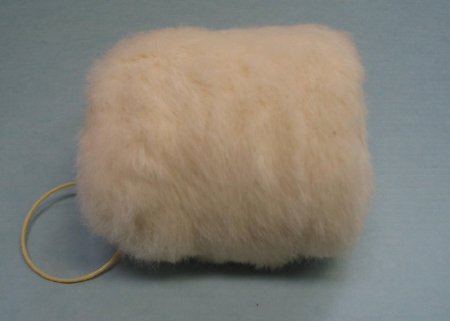Object ID:
2008.112.12.1
Label/Maker:
James McCreery
Date:
1940s
Object Details:
Muffs ebbed and flowed in popularity during the early part of the 20th century. Yet, there was a resurgence of this accessory in the 1940s as featured in this child's example made from white rabbit fur. During this time, "Sears and Roebuck advertised coney, meaning rabbit muffs, in their catalogues, which added a touch of glamour during this period in fashion history. The muff, though, would not survive the WWII era, as they were unsuited to modern women who drove cars, traveled on planes, lived in heated houses, and earned their own living."28 It's interesting to note that the children's market continued to incorporate muffs during the 1950s for girls with this accessory's suggestion of demureness; but this was short-lived as fur became controversial and muffs did not suit an active lifestyle.
Reference:
Compare to this record: Ackermann Fashion Plate
Cultural Connections:
The connections between the Regency Ackermann fashion plate and child's muff from the 1940s highlight moments in fashion history when fur accessories symbolized stylistic taste in response to environmental factors. "During the Regency period, fashion transformations were more notable and rapid than in any previous time in history. With the steady rise of industrialization came the impact of capitalism on society, and clothing served as a marker of the upward mobility that was newly available to many members of society."29 A chinchilla fur muff would certainly suit this trend noted for its dense silk-like material that was costly to produce. During the 1940s, the impact of WWII promoted governmental restrictions on fashion throughout Europe and the United States. As a result, accessories became a vehicle for style expression as individual's craved evidence of luxury in their wardrobes. A child's fur muff from this period, symbolizes a touch of glamour, beauty, and innocence.
Reference:
27 Britannica, T. Editors of Encyclopaedia, "Muff," Encyclopedia Britannica, September 22, 2010. https://www.britannica.com/topic/muff.
28 Sarah Murden, "Georgian Era Muffs, Tippets and Furs," All Things Georgian, February 23, 2016. https://georgianera.wordpress.com/2016/02/23/georgian-era-muffs-tippets-and-furs/.
29 Daniel James Cole, "Hierarchy and Seduction in Regency Fashion," Jane Austen Society of North America 33, no. 1 (2012), accessed November 25, 2020. http://www.jasna.org/persuasions/on-line/vol33no1/cole.html.

